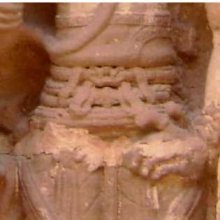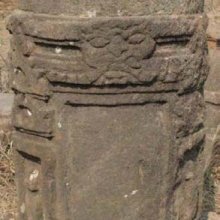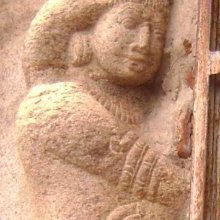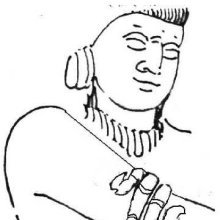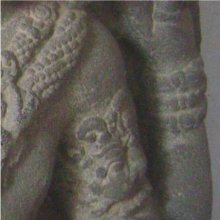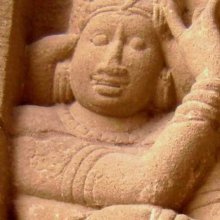Mukha: 32 definitions
Introduction:
Mukha means something in Buddhism, Pali, Hinduism, Sanskrit, Jainism, Prakrit, the history of ancient India, Marathi, Hindi. If you want to know the exact meaning, history, etymology or English translation of this term then check out the descriptions on this page. Add your comment or reference to a book if you want to contribute to this summary article.
Alternative spellings of this word include Mukh.
Images (photo gallery)
(+7 more images available)
In Hinduism
Shilpashastra (iconography)
Source: Google Books: The Theory of Citrasutras in Indian PaintingAccording to the Matsya Purāṇa, Mukha (face) is 12 aṅgulas.
Source: Shodhganga: The significance of the mūla-beras (śilpa)Mukha (“face”) refers to one of the several “attributes” (āyudha) or “accessories” of a detiy commonly seen depicted in Hindu iconography, defined according to texts dealing with śilpa (arts and crafs), known as śilpaśāstras.—The śilpa texts have classified the various accessories under the broad heading of āyudha or karuvi (implement), including even flowers, animals, and musical instruments. The other miscellaneous articles found as attributes in the hands of the deities are, for example, Mukha.

Shilpashastra (शिल्पशास्त्र, śilpaśāstra) represents the ancient Indian science (shastra) of creative arts (shilpa) such as sculpture, iconography and painting. Closely related to Vastushastra (architecture), they often share the same literature.
Purana and Itihasa (epic history)
Source: Cologne Digital Sanskrit Dictionaries: The Purana Index1a) Mukha (मुख).—The head of the Śiva Gaṇas.*
- * Brahmāṇḍa-purāṇa III. 41. 28.
1b) (Sukhas)—one of the three gaṇas;1 20 branches of them mentioned.2

The Purana (पुराण, purāṇas) refers to Sanskrit literature preserving ancient India’s vast cultural history, including historical legends, religious ceremonies, various arts and sciences. The eighteen mahapuranas total over 400,000 shlokas (metrical couplets) and date to at least several centuries BCE.
Natyashastra (theatrics and dramaturgy)
Source: Wisdom Library: Nāṭya-śāstra1) Mukha (मुख, “opening”) refers to one of the five segments (sandhi) of the plot (itivṛtta or vastu) of a dramatic play (nāṭaka), according to the Nāṭyaśāstra chapter 21. These five segments are assigned to the principal plot (ādhikārika). (Description): That part of a play, in which the creation of the Seed (bīja) as the source of many objects and Sentiments takes place, is called in relation to its body the Opening (mukha).
2) Mukha (मुख) refers to one of the two limbs (aṅga) belonging to Avakṛṣṭā type of song (dhruvā) defined in the Nāṭyaśāstra chapter 32.9-16. Accordingly, “depending on different conditions, the dhruvās are known to be of five classes”.
Source: Shodhganga: Elements of Art and Architecture in the Trtiyakhanda of the Visnudharmottarapurana (natya)Mukha (मुख) or Āmukha refers to the “beginning of the Drama”, according to the Sāhityadarpaṇa.—The Viṣṇudharmottarapurāṇa says that at the very beginning of the Sanskrit drama, praveśaka i.e., the introducer should introduce the plot of the drama that has been continuing for many days and this narration must be very brief. In the Sāhityadarpaṇa also, the description of those incidents which have already been happened are suggested in the very beginning of the Drama and the technical term of this part of a Drama is known as mukha or āmukha.

Natyashastra (नाट्यशास्त्र, nāṭyaśāstra) refers to both the ancient Indian tradition (shastra) of performing arts, (natya—theatrics, drama, dance, music), as well as the name of a Sanskrit work dealing with these subjects. It also teaches the rules for composing Dramatic plays (nataka), construction and performance of Theater, and Poetic works (kavya).
Vyakarana (Sanskrit grammar)
Source: Wikisource: A dictionary of Sanskrit grammarMukha (मुख).—Aperture of the mouth; the main place of the utterance of a letter.

Vyakarana (व्याकरण, vyākaraṇa) refers to Sanskrit grammar and represents one of the six additional sciences (vedanga) to be studied along with the Vedas. Vyakarana concerns itself with the rules of Sanskrit grammar and linguistic analysis in order to establish the correct context of words and sentences.
Jyotisha (astronomy and astrology)
Source: Wisdom Library: Brihat Samhita by VarahamihiraMukha (मुख) refers to the “head” (of Rāhu), according to the Bṛhatsaṃhitā (chapter 5), an encyclopedic Sanskrit work written by Varāhamihira mainly focusing on the science of ancient Indian astronomy astronomy (Jyotiṣa).—Accordingly, “Some say that Rāhu, the asura, though his head was cut, dies not but lives in the shape of a planet having tasted of ambrosia. That he has a disc like the sun and moon and as that disc is black it is invisible when in the sky except on the occasion of eclipses in virtue of a boon from Brahmā. Others say that he resembles a serpent in shape with his head [i.e., mukha] severed from his tail; a few that he is bodiless, that he is mere darkness and that he is the son of Siṃhikā. [...]”.
Source: Google Books: Studies in the History of the Exact Sciences (Astronomy)Mukha (मुख) refers to the “opening” (of a water-clock device), according to the Nāradasaṃhitā verse 29.86-95 (pp. 181-184), a Sanskrit work on astrology having the Saralā commentary by Vasatirāma Śarmā.—Accordingly, “[...] It should be pierced with a circular gold needle of three and one-third māṣas in weight and four aṅgulas in length. Then it is accurate. A copper bowl should be made with more than six palas (sic!). The diameter of the opening [i.e., mukha-viṣkambha] is twelve and the height six aṅgulas. Having made with one (sic!) māṣa of gold [a needle that is] four aṅgulas [in length], [with that] when the bowl (ghaṭikā) is pierced thus in the middle, it is then known as the water clock (nāḍikā) [...]”.
Source: Wikibooks (hi): Sanskrit Technical TermsMukha (मुख).—Face, top-side of an object or figure with more than three sides, especially the top or shorter/parallel side of a trapezium. Note: Mukha is a Sanskrit technical term used in ancient Indian sciences such as Astronomy, Mathematics and Geometry.

Jyotisha (ज्योतिष, jyotiṣa or jyotish) refers to ‘astronomy’ or “Vedic astrology” and represents the fifth of the six Vedangas (additional sciences to be studied along with the Vedas). Jyotisha concerns itself with the study and prediction of the movements of celestial bodies, in order to calculate the auspicious time for rituals and ceremonies.
Ayurveda (science of life)
Source: gurumukhi.ru: Ayurveda glossary of termsMukha (मुख):—[mukhaṃ] Mouth, Face, Opening

Āyurveda (आयुर्वेद, ayurveda) is a branch of Indian science dealing with medicine, herbalism, taxology, anatomy, surgery, alchemy and related topics. Traditional practice of Āyurveda in ancient India dates back to at least the first millenium BC. Literature is commonly written in Sanskrit using various poetic metres.
Vastushastra (architecture)
Source: OpenEdition books: Architectural terms contained in Ajitāgama and RauravāgamaMukha (मुख) refers to “face (of a stone) § 2.11.”.—(For paragraphs cf. Les enseignements architecturaux de l'Ajitāgama et du Rauravāgama by Bruno Dagens)

Vastushastra (वास्तुशास्त्र, vāstuśāstra) refers to the ancient Indian science (shastra) of architecture (vastu), dealing with topics such architecture, sculpture, town-building, fort building and various other constructions. Vastu also deals with the philosophy of the architectural relation with the cosmic universe.
In Buddhism
Mahayana (major branch of Buddhism)
Source: Wisdom Library: Maha Prajnaparamita Sastra1) Mukha (मुख, “mouth”) refers to that part of the human body from which the Buddha emitted numerous rays when he smiled with his whole body after contemplating the entire universe, according to the 2nd century Mahāprajñāpāramitāśāstra (chapter XIV).—Accordingly, having himself arranged the lion-seat, the Bhagavat sat down cross-legged; holding his body upright and fixing his attention, he entered into the samādhirājasamādhi. Then, having tranquilly come out of this samādhi and having contemplated the entire universe with his divine eye (divyacakṣus), the Bhagavat smiled with his whole body. Wheels with a thousand spokes imprinted on the soles of his feet (pādatala) shoot out six hundred prabhedakoṭi of rays. In the same way, beams of six hundred prabhedakoṭi of rays are emitted from his mouth (mukha).
2) Mukha (मुख, “mouth”) refers to the “two gates of the Buddhist system”, according to chapter XLVII.—Accordingly, “the Buddhist system has two gates (mukha): i) the gate of absolute meaning (parāmārtha); ii) the gate of conventional meaning. Conventionally, the Bodhisattva wants the Buddhas to praise him, but when he is praised by the Buddhas, he does not see in himself any substantial self (ātman) and does not grasp any nature of existence. It is purely a manner of speaking (lokaprajñati), therefore, that the sūtra expresses itself thus”.
Source: academia.edu: A Study and Translation of the GaganagañjaparipṛcchāMukha (मुख) refers to the “gate (of knowledge)”, according to the Gaganagañjaparipṛcchā: the eighth chapter of the Mahāsaṃnipāta (a collection of Mahāyāna Buddhist Sūtras).—Accordingly, “How then, son of good family, does the Bodhisattva perform his practice of a Bodhisattva (bodhisattvacaryā) after having obtained the sameness of extinction? [...] Even though he is established in the sameness of extinction, he still does not interrupt bringing living beings to maturity. This, son of good family, is the gate of knowledge (jñāna-mukha) called the development of two approaches, [namely the great compassion and expedient means], of the Bodhisattvas. Even though the Bodhisattva is placed in the gate of knowledge after having obtained the sameness of extinction, he still performs the practice of a Bodhisattva. [...]”.

Mahayana (महायान, mahāyāna) is a major branch of Buddhism focusing on the path of a Bodhisattva (spiritual aspirants/ enlightened beings). Extant literature is vast and primarely composed in the Sanskrit language. There are many sūtras of which some of the earliest are the various Prajñāpāramitā sūtras.
Tibetan Buddhism (Vajrayana or tantric Buddhism)
Source: Brill: Śaivism and the Tantric Traditions (tantric Buddhism)Mukha (मुख) or Ānana refers to the “face”, according to the Nāmamantrārthāvalokinī by Vilāsavajra, which is a commentary on the Nāmasaṃgīti.—Accordingly, [while describing Ādibuddha]—“[...] [The Ādibuddha] has five faces (pañcan-ānana > pañcan-amukha). [He also] has five crests—in other words, five hair-braids. It is through tying up those [hair-braids that he] has a crown of five hair-braids. [His five faces] have five [different] colours: dark blue for the east [and forward-facing face], yellow for the south, red for the west, [and] green for the north. [...]”.

Tibetan Buddhism includes schools such as Nyingma, Kadampa, Kagyu and Gelug. Their primary canon of literature is divided in two broad categories: The Kangyur, which consists of Buddha’s words, and the Tengyur, which includes commentaries from various sources. Esotericism and tantra techniques (vajrayāna) are collected indepently.
In Jainism
General definition (in Jainism)
Source: The University of Sydney: A study of the Twelve ReflectionsMukha (मुख) refers to the “mouth (of a serpent)”, according to the 11th century Jñānārṇava, a treatise on Jain Yoga in roughly 2200 Sanskrit verses composed by Śubhacandra.—Accordingly, “The three worlds, which are made foolish by the action of the poison of lust, are fast asleep in this gaping mouth of Yama’s serpent [com.—yamanāga-mukhavivara—‘the gaping mouth of Yama’s serpent’] which is marked by fangs of destruction. While this one whose disposition is pitiless is devouring everyone, certainly there is no way out from this for you, noble fellow, by any means [even] with some difficulty without knowledge of what is beyond the senses. [Thus ends the reflection on] helplessness”.
Synonyms: Vaktra, Vadana.

Jainism is an Indian religion of Dharma whose doctrine revolves around harmlessness (ahimsa) towards every living being. The two major branches (Digambara and Svetambara) of Jainism stimulate self-control (or, shramana, ‘self-reliance’) and spiritual development through a path of peace for the soul to progess to the ultimate goal.
India history and geography
Source: Cologne Digital Sanskrit Dictionaries: Indian Epigraphical GlossaryMukha.—(EI 22; LL), the face, the gate; a door. Cf. dāna-mukha (ML), the principal gift. (EI 16), used at the end of compounds in the sense of mukhya; ‘head’ ‘heading’ or ‘sum’. Cf. pañca-mukha-nagara. Cf. muha-patti. Note: mukha is defined in the “Indian epigraphical glossary” as it can be found on ancient inscriptions commonly written in Sanskrit, Prakrit or Dravidian languages.

The history of India traces the identification of countries, villages, towns and other regions of India, as well as mythology, zoology, royal dynasties, rulers, tribes, local festivities and traditions and regional languages. Ancient India enjoyed religious freedom and encourages the path of Dharma, a concept common to Buddhism, Hinduism, and Jainism.
Languages of India and abroad
Pali-English dictionary
Source: BuddhaSasana: Concise Pali-English Dictionarymukha : (nt.) mouth; face; entrance; opening; front. (adj.), foremost.
Source: Sutta: The Pali Text Society's Pali-English DictionaryMukha, (nt.) (Vedic mukha, fr. Idg. *mu, onomat. , cp. Lat. mu facere, Gr. mukάomai, Mhg. mūgen, Lat. mūgio to moo (of cows), to make the sound “moo”; Ohg. māwen to cry, muckazzen to talk softly; also Gr. mu_qos word, “myth”; Ohg. mūla=Ger. maul; Ags. mule snout, etc. Vedic mūka silent, dumb=Lat. mutus=E. mute) 1. the mouth Sn. 608, 1022 (with ref. to the long tongue, pahūta-jivha, of the Buddha or Mahāpurisa); J. II, 7; DA. I, 287 (uttāna° clear mouthed, i.e. easy to understand, cp. D. I, 116); PvA. 11, 12 (pūti°), 264 (mukhena).—2. the face J. VI, 218 (uṇṇaja m.); PvA. 74, 75, 77; °ṃ karoti to make a face (i.e. grimace) Vism. 343.—adho° face downward Vin. II, 78; opp. upari° (q. v.); assu° with tearful face Dh. 67; PvA. 39; see assu.—dum° (adj.) sad or unfriendly looking J. II, 393; VI, 343; scurrilous J. V, 78; bhadra° brightfaced PvA. 149; ruda° crying Pv. I, 112.—3. entrance, mouth (of a river) Mhvs 8, 12; āya° entrance (lit. opening), i.e. cause or means of income DA. I, 218; ukkā° the opening of a furnace, a goldsmith’s smelting pot A. I, 257; Sn. 686; J. VI, 217; 574. ubhato-mukha having 2 openings M. I, 57. sandhi° opening of the cleft PvA. 4. Hence: — 4. cause, ways, means, reason, by way of J. III, 55 by way of a gift (dānamukhe); IV, 266 (bahūhi mukhehi).—apāya° cause of ruin or loss A. II, 166; IV, 283.—5. front part, front, top, in īsā° of the carriage pole S. I, 224=J. I, 203. Hence: — 6. the top of anything, front, head, best part; adj. topmost, foremost Sn. 568 (aggihutta-mukhā yaññā), 569 (nakkhattānaṃ mukhaṃ cando; cp. Vin. I, 246); VbhA. 332 (=uttamaṃ, mukha-bhūtaṃ vā).—Der. adj. mokkha & pāmokkha (q. v.). Note. A poetical Instr. sg. mukhasā is found at Pv. I, 23 & I. 32, as if the Nom. were mukho (s-stem).—The Abl. mukhā is used as adv. “in front of, before, ” in cpd. sam° & param°, e.g. PvA. 13. See each sep.
—ādhāna (1) the bit of a bridle M. I, 446; (2) setting of the mouth, i.e. mouth-enclosure, rim of the m.; in m. siliṭṭhaṃ a well-connected, well-defined mouth-contour DhsA. 15 (not with trsl. “opens lightly, ” but better with note “is well adjusted, ” see Expos. 19, where write °ādhāna for °ādāna).—āsiya (? cp. āsita1) to be eaten by the mouth DhsA. 330 (mukhena asitabba).—ullokana looking into a person’s face, i.e. cheerful, bright, perhaps also flattering DhA. II, 193 (as °olokana).—ullokika flattering (cp. above) Nd1 249 (puthu Satthārānaṃ m. puthujjana); PvA. 219.—odaka water for rinsing the mouth Nd2 391=Miln. 370; VvA. 65; DhA. II, 19; IV, 28.—ja born in (or from) the mouth, i.e. a tooth J. VI, 219.—tuṇḍa a beak VvA. 227 (cp. BSk. mukhatuṇḍaka Divy 387).—dugga one whose mouth is a difficult road, i.e. one who uses his mouth (speech) badly Sn. 664 (v. l. °dukkha).—dūsi blemishes of the face, a rash on the face DA. I, 223 (m.—dosa ibid.).—dvāra mouth opening PvA. 180.—dhovana-ṭṭhāna place for rinsing the mouth, “lavatory” DhA. II, 184.—puñchana wiping one’s mouth Vin. I, 297.—pūra filling the mouth, a mouthful, i.e. as much as to fill the mouth J. VI, 350.—pūraka mouth-filling Vism. 106.—bheri a musical instrument, “mouth-drum, ” mouthorgan (?) Nd2 219 B; SnA 86.—makkaṭika a grimace (like that of a monkey) of the face J. II, 70, 448 (T. makkaṭiya).—vaṭṭi “opening-circumference, ” i.e. brim, edge, rim DhA. II, 5 (of the Lohakumbhi purgatory, cp. J. III, 43 lohakumbha-mukhavaṭṭi); DhA. III, 58 (of a gong).—vaṇṇa the features PvA. 122, 124.—vikāra contortion of the mouth J. II, 448.—vikūṇa (=vikāra) grimace SnA 30.—saṅkocana distortion or contraction of the mouth, as a sign of displeasure DhA. II, 270; cp. mukha-saṅkoca Vism. 26.—saññata controlling one’s mouth (i.e. speech) Dh. 363, cp. DhA. IV, 93. (Page 534)

Pali is the language of the Tipiṭaka, which is the sacred canon of Theravāda Buddhism and contains much of the Buddha’s speech. Closeley related to Sanskrit, both languages are used interchangeably between religions.
Marathi-English dictionary
Source: DDSA: The Molesworth Marathi and English Dictionarymukha (मुख).—n (S) The mouth. S adage. mukhamastīti vaktavyaṃ Used in reproof of one who speaks because he has a mouth. 2 The face. 3 fig. The entrance into a building; the beginning of a work &c. For other figurative senses see tōṇḍa. 4 A means, measure, expedient. 5 S In comp. The fore, prime, or initial thing or part: also the chief, principal, or leading person. 6 In arithmetic &c. The first term of a series. 7 The opposite side to the base of any quadrilateral figure.
--- OR ---
mukhā (मुखा).—m The expanded or broad end of a hammer. Opp. to pisā.
Source: DDSA: The Aryabhusan school dictionary, Marathi-Englishmukha (मुख).—n The mouth; the face. A means.
--- OR ---
mukhā (मुखा).—m The broad end of a hammer.
Marathi is an Indo-European language having over 70 million native speakers people in (predominantly) Maharashtra India. Marathi, like many other Indo-Aryan languages, evolved from early forms of Prakrit, which itself is a subset of Sanskrit, one of the most ancient languages of the world.
Sanskrit dictionary
Source: DDSA: The practical Sanskrit-English dictionaryMukha (मुख).—[khan ac ḍit dhātoḥ pūrvaṃ muṭ ca cf. Uṇādi-sūtra 5.2]
1) The mouth (fig. also); प्रजासृजा यतः खातं तस्मादाहुर्मुखं बुधाः (prajāsṛjā yataḥ khātaṃ tasmādāhurmukhaṃ budhāḥ); ब्राह्मणोऽस्य मुखमासीत् (brāhmaṇo'sya mukhamāsīt) Ṛv.1.9.12; सभ्रूभङ्गं मुखमिव (sabhrūbhaṅgaṃ mukhamiva) Meghadūta 24; त्वं मम मुखं भव (tvaṃ mama mukhaṃ bhava) V.1 'be my mouth or spokesman'.
2) The face, countenance; परिवृत्तार्धमुखी मयाद्य दृष्टा (parivṛttārdhamukhī mayādya dṛṣṭā) V.1.17; नियमक्षाममुखी धृतैकवेणिः (niyamakṣāmamukhī dhṛtaikaveṇiḥ) Ś.7.21; so चन्द्रमुखी, मुखचन्द्रः (candramukhī, mukhacandraḥ) &c; ओष्ठौ च दन्तमूलानि दन्ता जिह्वा च तालु च । गलो गलादि सकलं सप्ताङ्गं मुखमुच्यते (oṣṭhau ca dantamūlāni dantā jihvā ca tālu ca | galo galādi sakalaṃ saptāṅgaṃ mukhamucyate) ||
3) The snout or muzzle (of any animal).
4) The front, van, forepart; head, top; (locane) हरति मे हरिवाहनदिङ्मुखम् (harati me harivāhanadiṅmukham) V.3.6.
5) The tip, point, barb (of an arrow), head; पुरारि- मप्राप्तमुखः शिलीमुखः (purāri- maprāptamukhaḥ śilīmukhaḥ) Kumārasambhava 5.54; R.3.57.
6) The edge or sharp point (of any instrument).
7) A teat, nipple; मध्ये यथा श्याममुखस्य तस्य मृणालसूत्रान्तरमप्य- लभ्यम् (madhye yathā śyāmamukhasya tasya mṛṇālasūtrāntaramapya- labhyam) Kumārasambhava 1.4; R.3.8.
8) The beak or bill of a bird.
9) A direction, quarter; as in अन्तर्मुख (antarmukha).
1) Opening, entrance, mouth; नीवाराः शुकगर्भकोटरमुखभ्रष्टास्तरूणामधः (nīvārāḥ śukagarbhakoṭaramukhabhraṣṭāstarūṇāmadhaḥ) Ś.1.14; नदीमुखेनेव समुद्रमाविशत् (nadīmukheneva samudramāviśat) R.3.28; Kumārasambhava 1.8.
11) An entrance to a house, a door, passage.
12) Beginning, commencement; सखीजनोद्वीक्षणकौमुदीमुखम् (sakhījanodvīkṣaṇakaumudīmukham) R.3.1; दिनमुखानि रविर्हिमनिग्रहैर्विमलयन् मलयं नगमत्यजत् (dinamukhāni ravirhimanigrahairvimalayan malayaṃ nagamatyajat) 9.25;5.76; Ghaṭ.2.
13) Introduction.
14) The chief, the principal or prominent (at the end of comp. in this sense); बन्धोन्मुक्त्यै खलु मखमुखान् कुर्वते कर्मपाशान् (bandhonmuktyai khalu makhamukhān kurvate karmapāśān) Bv.4.21; so इन्द्रमुखा देवाः (indramukhā devāḥ) &c.
15) The surface or upper side.
16) A means.
17) A source, cause, occasion.
18) Utterance; as in मुखसुख (mukhasukha); speaking, speech, tongue; आत्मनो मुखदोषेण बध्यन्ते शुकसारिकाः (ātmano mukhadoṣeṇa badhyante śukasārikāḥ) Pañcatantra (Bombay) 4.44.
19) The Vedas, scripture.
2) (In Rhet.) The original cause or source of the action in a drama.
21) The first term in a progression (in alg.).
22) The side opposite to the base of a figure (in geom.).
Derivable forms: mukham (मुखम्).
Source: Cologne Digital Sanskrit Dictionaries: Shabda-Sagara Sanskrit-English DictionaryMukha (मुख).—mfn.
(-khaḥ-khā-khaṃ) 1. First, initial. 2. Chief, pre-eminent, principal. n.
(-khaṃ) 1. The mouth. 2. The face. 3. The entrance to a house. 4. Commencement. 5. A means, an expedient. 6. Sound. 7. The opening division of a drama, the first act, &c. 8. The previous or preparatory incidents of a drama. 9. A direction, a quarter. 10. Opening, entrance. 11. The head, the top, the tip. 12. The edge of any sharp instrument. 13. Utterance. 14. Source, cause, occasion. 15. The Vedas, scripture. m.
(-khaḥ) The beak of a bird. E. khan to dig, Unadi aff. ac with the power of ḍa, by which the final is rejected, muṭa initial augment.
Source: Cologne Digital Sanskrit Dictionaries: Benfey Sanskrit-English DictionaryMukha (मुख).—I. n. 1. The mouth, [Pañcatantra] 258, 16. 2. The face, [Pañcatantra] 238, 23. 3. Front, [Draupadīpramātha] 8, 8. 4. Entrance, [Uttara Rāmacarita, 2. ed. Calc., 1862.] 15, 19; the entrance to a house. 5. An aperture, [Śiśupālavadha] 9, 2. 6. Commencement, [Pañcatantra] 29, 16;
Mukha (मुख).—[neuter] mouth, face, beak, snout, (adj. —° having — in the mouth etc. or having a like mouth); direction, quarter (adj. —° turned towards, facing, [neuter] [adverb]); opening, aperture, entrance into ([genetive] or —°); forepart, top, point, edge, surface; head, chief, best; commencement, introduction (adj. —° ±ādi beginning with); cause, occasion, means of, [instrumental] mukhena by means of ([genetive] or —°).
Source: Cologne Digital Sanskrit Dictionaries: Monier-Williams Sanskrit-English Dictionary1) Mukha (मुख):—n. (m. [gana] ardharcādi; ifc. f(ā, or ī). cf. [Pāṇini iv, 1, 54, 58]) the mouth, face, countenance, [Ṛg-veda] etc., etc.
2) the beak of a bird, snout or muzzle of an animal, [Gṛhya-sūtra; Manu-smṛti; Mahābhārata] etc.
3) a direction, quarter ([especially] ifc. cf. diṅ-m; mfn. turning or turned towards, facing cf. adho-m also ind (am). cf. prān-mukham)
4) the mouth or spout of a vessel, [Kātyāyana-śrauta-sūtra]
5) opening aperture, entrance into or egress out of ([genitive case] or [compound]), [Mahābhārata; Kāvya literature] etc.
6) the mouth or embouchure (of a river), [Raghuvaṃśa]
7) the fore part, front, van (of an army), [Taittirīya-brāhmaṇa; Mahābhārata]
8) the upper part, head, top, tip or point of anything, [Vājasaneyi-saṃhitā; Brāhmaṇa; Mahābhārata] etc. (also mfn. in [compound] cf. payo-m)
9) the edge (of an axe), [Kāvya literature]
10) the nipple (of a breast), [Harivaṃśa]
11) the surface, upper side, [Āryabhaṭa [Scholiast or Commentator]]
12) the chief, principal, best (ifc. = having any one or anything as chief etc.), [Śatapatha-brāhmaṇa; Mahābhārata] etc.
13) introduction, commencement, beginning (ifc. = beginning with; also -mukhādi cf. the use of ādi), [Brāhmaṇa; Mahābhārata; Kāvya literature] etc.
14) source, cause, occasion of ([genitive case] or [compound]), [Mahābhārata]
15) a means (khena ind. by means of), [Śaṃkarācārya]
16) (in [dramatic language]) the original cause or source of the action, [Daśarūpa; Pratāparudrīya]
17) (in [algebra]) the first term or initial quantity of a progression, [Colebrooke]
18) (in [geometry]) the side opposite to the base, the summit, [ib.]
19) the Veda, [cf. Lexicographers, esp. such as amarasiṃha, halāyudha, hemacandra, etc.]
20) rock salt, [cf. Lexicographers, esp. such as amarasiṃha, halāyudha, hemacandra, etc.]
21) copper, [cf. Lexicographers, esp. such as amarasiṃha, halāyudha, hemacandra, etc.]
22) m. Artocarpus Locuchs, [cf. Lexicographers, esp. such as amarasiṃha, halāyudha, hemacandra, etc.]
Source: Cologne Digital Sanskrit Dictionaries: Yates Sanskrit-English DictionaryMukha (मुख):—(khaṃ) 1. n. The mouth; face; commencement. m. Beak of a bird. a. First, initial, chief.
Source: DDSA: Paia-sadda-mahannavo; a comprehensive Prakrit Hindi dictionary (S)Mukha (मुख) in the Sanskrit language is related to the Prakrit words: Mukha, Muha.
[Sanskrit to German]
Sanskrit, also spelled संस्कृतम् (saṃskṛtam), is an ancient language of India commonly seen as the grandmother of the Indo-European language family (even English!). Closely allied with Prakrit and Pali, Sanskrit is more exhaustive in both grammar and terms and has the most extensive collection of literature in the world, greatly surpassing its sister-languages Greek and Latin.
Hindi dictionary
Source: DDSA: A practical Hindi-English dictionaryMukha (मुख) [Also spelled mukh]:—(nm) the mouth; face; forepart; front; brim; opening; exit or entrance; principal; -[kamala] lotus-like face, lovely/beautiful face; -[kāṃti] facial lustre; -[citra] the frontice piece; cover-design; -[paṭa] a veil; -[patra] an organ; ~[pṛṣṭha] the cover page; -[prakṣālana] washing the face; ~[maṃḍala] the face, countenance; ~[baṃdha] the preface, introduction; ~[śuddhi] cleansing or purifying the mouth after meals; chewing a betel etc. after meals; ~[śrī] facial glow, face-lustre; —[sukha] economy of effort (in pronunciation); (causing) ease of pronunciation; ~[strāva] the saliva.
...
Prakrit-English dictionary
Source: DDSA: Paia-sadda-mahannavo; a comprehensive Prakrit Hindi dictionaryMukha (मुख) in the Prakrit language is related to the Sanskrit word: Mukha.
Prakrit is an ancient language closely associated with both Pali and Sanskrit. Jain literature is often composed in this language or sub-dialects, such as the Agamas and their commentaries which are written in Ardhamagadhi and Maharashtri Prakrit. The earliest extant texts can be dated to as early as the 4th century BCE although core portions might be older.
Kannada-English dictionary
Source: Alar: Kannada-English corpusMukha (ಮುಖ):—
1) [noun] the opening through which an animal or human takes in food; the mouth.
2) [noun] the front of the humanfrom the forehead to the chin and ear to ear; the face.
3) [noun] corresponding part of an animal body.
4) [noun] the horny projecting mouth of a bird; the beak.
5) [noun] the part of something that faces forward or is regarded as facing forward; front portion.
6) [noun] the open yard outside a house, adjoining the main entrance.
7) [noun] the pointed edge (of an arrow, spear, etc.).
8) [noun] the small protuberance on a woman’s breast through which the milk passes in suckling the young; the teat; the nipple.
9) [noun] the mouth of a container.
10) [noun] the blade of a weapon.
11) [noun] the upper or prominent part.
12) [noun] the outer surface.
13) [noun] a hole; a cavity.
14) [noun] the point toward which something faces or theline along which something moves or lies; a direction.
15) [noun] the place where a river empties itself into a sea or ocean.
16) [noun] a beginning.
17) [noun] a means used to achieve an end.
18) [noun] a position or space beside one; a side.
19) [noun] anything producing an effect or result.
20) [noun] the act of uttering, speaking; utterance.
21) [noun] the time at which something happens; an occaion.
22) [noun] a way, manner (in which something is done or is to be done).
23) [noun] the state of (two persons or things) facing each other.
24) [noun] that which is superior, excellent.
25) [noun] the quality of being prominant; prominence.
26) [noun] a prominent or pre-eminent man.
27) [noun] the fact or condition of being present; presence.
28) [noun] attention; regard; observation.
29) [noun] (fig.) courage that one gets from his or her being honest, moral, etc.; moral courage.
30) [noun] ಮುಖಕ್ಕೆ ತಣ್ಣೀರೆರಚು [mukhakke tannireracu] mukhakketaṇṇīrercu to discourage or show unenthusiastic reaction to; ಮುಖ ಕೊಟ್ಟು ಮಾತನಾಡು [mukha kottu matanadu] mukha koṭṭu mātanāḍu to talk to another person looking at his or her face without guilt or diffidence; to have warmth between, while talking to another; ಮುಖ ಕೆಳಗೆ ಹಾಕು [mukha kelage haku] mukha keḷage hāku to hang one’s head in shame, ill-treatment, etc.; ಮುಖ ಗಡಿಗೆಯಾಗು [mukha gadigeyagu] mukha gaḍigeyāgu (the face) to become stiff and unfriendly from dissatisfaction, disapproval or dissent; ಮುಖ ತೋರಿಸು [mukha torisu] mukha tōrisu to come to be seen; to appear in person; ಮುಖ ಕಿವಿಚು [mukha kivicu] mukha kivicu to distort one’s face from abhorrence, aversion, repugnance or irony; ಮುಖಕ್ಕೆ ಮಸಿ ಬಳಿ [mukhakke masi bali] mukhakke masi baḷi to besmirch or sully (a reputation, honor, etc.); ಮುಖ ಗಂಟಿಕ್ಕು [mukha gamtikku] mukha ganṭikku to look with displeasure; to frown from disappointment, repugnance, etc.; ಮುಖ ಗಂಟುಹಾಕಿಕೊಳ್ಳು [mukha gamtuhakikollu] mukha gaṇṭu hākikoḷḷu = ಮುಖ ಗಂಟಿಕ್ಕು [mukha gamtikku]; ಮುಖ ಚಿಕ್ಕದಾಗು [mukha cikkadagu] mukha cukkadāgu (the face) to become lustreless from disappointment, dejection, loss of courage, despondency, from being slighted, ill treated, etc.; ಮುಖ ಕೆಡು [mukha kedu] mukha keḍu = ಮುಖ ಕಪ್ಪಾಗು [mukha kappagu]; ಮುಖ ತಿವಿ [mukha tivi] mukha tivi to talk in a very insolent manner; to insult openly and purposely; to affront; ಮುಖ ಕೆಂಪಗಾಗು [mukha kempagagu] mukha kempagāgu (the face) to become red from shyness, embarrassment; to be abashed; ಮುಖ ಸಿಂಡರಿಸಿಕೊಳ್ಳು [mukha simdarisikollu] mukha siṇḍarisikoḷḷu = ಮುಖ ಗಂಟಿಕ್ಕು [mukha gamtikku]; ಮುಖ ಕಿರಿದಾಗು [mukha kiridagu] mukha kiridāgu = ಮುಖ ಚಿಕ್ಕದಾಗು [mukha cikkadagu]; ಮುಖ ಕಪ್ಪಿಡು [mukha kappidu] mukha kappiḍu = ಮುಖ ಕಪ್ಪಾಗು [mukha kappagu]; ಮುಖ ಸೊಟ್ಟಗೆ ಮಾಡು [mukha sottage madu] mukha soṭṭage māḍu = ಮುಖ ಕಿವಿಚು [mukha kivicu]; ಮುಖ ಎತ್ತಿ ತಿರುಗು [mukha etti tirugu] mukha etti tirugu to live with dignity and honour (in a society); ಮುಖ ಮರೆಸಿಕೊಳ್ಳು [mukha maresikollu] mukha maresikoḷḷu to avoid being seen (from shame, loss of reputation, dishonour, etc.); ಮುಖ ಜೋಲುಬಿಡು [mukha jolubidu] mukha jōlu biḍu to have an unhappy, gloomy or disconsolate facial expression; to have a long face; ಮುಖ ಕಪ್ಪಗೆ ಮಾಡಿಕೊಳ್ಳು [mukha kappage madikollu] mukha kappage māḍikoḷḷu to become very dull; to lose energy, vigour, enthusiasm, zeal, etc.; ಮುಖ ಮುರಿ [mukha muri] mukha muri to treat contemptuously or despicably; to abash; 2. to turn back, retreat, from fear; ಮುಖ ತಗ್ಗಿಸು [mukha taggisu] mukha taggisu = ಮುಖ ಕೆಳಗೆ ಹಾಕು [mukha kelage haku]; ಮುಖ ಸುಕ್ಕು [mukha sukku] mukha sukku = ಮುಖ ಕಿವಿಚು [mukha kivicu]; ಮುಖ ಕಪ್ಪಾಗು [mukha kappagu] mukha kappāgu (the face) to become black or blackish; 2. to become lustreless, dull, from guilt, disappointment, etc.; ಮುಖಕೆಂಪೇರು [mukhakemperu] mukha kempēru = ಮುಖ ಕೆಂಪಗಾಗು [mukha kempagagu]; ಮುಖದ ನೀರಿಳಿಸು [mukhada nirilisu] mukhada nīriḷisu to lower the pride or conceit of; to take down a peg; ಮುಖ [mukha] (ಮುಖ [mukha]) ನೋಡು [nodu] mukha (mukha) nōḍu to blink blankly; ಮುಖ ಬಿಳಚಿಕೊಳ್ಳು [mukha bilacikollu] mukha biḷacikoḷḷu to become pale (from guilt); ಮುಖಕ್ಕೆ ಮಂಗಳಾರತಿ ಎತ್ತು [mukhakke mamgalarati ettu] mukhakfke maṃgaḷārati ettu to scold or condemn sharply; ಮುಖ ತಪ್ಪಿಸಿಕೊಳ್ಳು [mukha tappisikollu] mukha tappisikoḷḷu = ಮುಖ ಮರೆಸಿಕೊಳ್ಳು [mukha maresikollu]; ಮುಖ ಸಣ್ಣದಾಗು [mukha sannadagu] mukha saṇṇadāgu = ಮುಖ ಚಿಕ್ಕದಾಗು [mukha cikkadagu]; ಮುಖ ತಿರುಗಿಸು [mukha tirugisu] mukha tirugisu to turn one’s face aside, from disapproval, repugnance; ಮುಖ ನೋಡಿ ಮಣೆ ಹಾಕು [mukha nodi mane haku] mukha nōḍi maṇe hāku to treat people differentially or biasedly depeding on their status, wealth, etc.; ಮುಖವರಳು [mukhavaralu] mukhavaraḷu (face) to gleam with gladness, satisfaction, etc.; ಮುಖದ ನೀರಿಳಿಕು [mukhada niriliku] mukhada nīriḷiku = ಮುಖದ ನೀರಿಳಿಸು [mukhada nirilisu]; ಮುಖ ಪರಚಿಕೊಳ್ಳು [mukha paracikollu] mukha paracikoḷḷu to become desparate from disappointment or helplessness; ಮುಖ ದಪ್ಪಗೆ ಮಾಡಿಕೊಳ್ಳು [mukha dappage madikollu] mukha dappage māḍikoḷḷu to have a stiff and unfriendly countenance, expresing one’s dissatisfaction, disapproval or dissent.
Kannada is a Dravidian language (as opposed to the Indo-European language family) mainly spoken in the southwestern region of India.
See also (Relevant definitions)
Starts with (+368): Mukha-ahara, Mukha-bujo-launu, Mukha-chadnu, Mukha-dekhauni, Mukha-dekhaunu, Mukha-dhunu, Mukha-kattana, Mukha-phornu, Mukhabahurupadatas, Mukhabahurupajja, Mukhabandh, Mukhabandha, Mukhabandhana, Mukhabele, Mukhabhadra, Mukhabhaga, Mukhabhamgita, Mukhabhamgite, Mukhabhanga, Mukhabhangi.
Ends with (+779): Abaddhakamukha, Abaddhamukha, Abhimukha, Abhisammukha, Abhrabhimukha, Adamukha, Adarshamukha, Adasamukha, Addamukha, Adheyyamukha, Adhomukha, Adimukha, Adurmukha, Aggimukha, Agnimukha, Agramukha, Aharamukha, Aharmukha, Ahomukha, Aimukha.
Full-text (+1386): Adhomukha, Trayimukha, Mukhastra, Matrimukha, Abaddhamukha, Mukhanivasini, Ubhayatomukha, Mukhanga, Mukhadhauta, Mukhashapha, Mukhapata, Mukhalangala, Mukhavallabha, Mukhasrava, Kelimukha, Kritamukha, Mukhashodhin, Mukhaghanta, Naktamukha, Mukhapinda.
Relevant text
Search found 152 books and stories containing Mukha, Mukhā; (plurals include: Mukhas, Mukhās). You can also click to the full overview containing English textual excerpts. Below are direct links for the most relevant articles:
Garga Samhita (English) (by Danavir Goswami)
Verse 6.1.25 < [Chapter 1 - Jarāsandha’s Defeat]
Verse 2.14.9 < [Chapter 14 - Description of Kāliya’s Story]
Verse 1.14.56 < [Chapter 14 - The Liberation of Śakaṭāsura and Tṛṇāvarta]
Maha Prajnaparamita Sastra (by Gelongma Karma Migme Chödrön)
III. Differences between dhāraṇi-mukha and samādhi-mukha < [Part 4 - Obtaining the gates of recollection and concentration]
Appendix 3 - Balance of power between the Devas and the Asuras < [Chapter XLVI - Venerating with the Roots of Good]
II. Gates of concentration (samādhi-mukha) < [Part 4 - Obtaining the gates of recollection and concentration]
Mandukya Upanishad (Madhva commentary) (by Srisa Chandra Vasu)
Mantra 1.6 < [Chapter 1 - First Khanda]
Mantra 1.3 < [Chapter 1 - First Khanda]
Mantra 1.5 < [Chapter 1 - First Khanda]
Sahitya-kaumudi by Baladeva Vidyabhushana (by Gaurapada Dāsa)
Text 10.18 < [Chapter 10 - Ornaments of Meaning]
Text 10.193 < [Chapter 10 - Ornaments of Meaning]
Text 10.6 < [Chapter 10 - Ornaments of Meaning]
Shrimad Bhagavad-gita (by Narayana Gosvami)
Verse 1.28 < [Chapter 1 - Sainya-Darśana (Observing the Armies)]
Verse 10.33 < [Chapter 10 - Vibhūti-yoga (appreciating the opulences of the Supreme Lord)]
Verses 11.10-11 < [Chapter 11 - Viśvarūpa-darśana-yoga (beholding the Lord’s Universal Form)]
Rig Veda (translation and commentary) (by H. H. Wilson)
Related products
